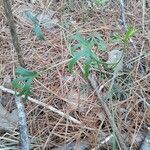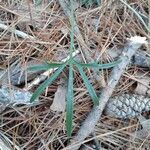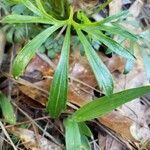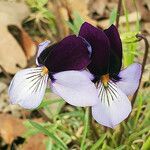Perennial herb, glabrous or slightly pubescent; rootstock short, erect; stolons absent. Leaves radical, crowded; lamina reniform, ovate or elliptic, pedately 3–9-lobed, base attenuate or broadly cordate to cuneate; lobes spathulate to lanceolate, deltate or ovate, 1–4 cm long; petiole 2–12 cm long; stipules linear-lanceolate, acute, entire, lacerate, adnate. Flower-scapes 5–12 cm long. Sepals lanceolate, c. 7 mm long, with small basal appendages. Petals usually 12–24 mm long, light to dark blue-violet, glabrous, the anterior with a short basal spur, often white near base. Style clavate. Capsule ellipsoid, 6–10 mm long. Seed 1.4–3 mm long, beige, mottled brown.
Acaulescent, with an erect rootstock, not stoloniferous, glabrous or nearly so; principal lvs 3-parted, the lateral segments again 3–5-cleft into linear or lanceolate divisions often with 2–4 teeth near the tip; fls 2–4 cm wide; pet beardless, all lilac-purple, or less commonly the upper 2 dark violet; tips of the large, orange stamens conspicuously exsert; cleistogamous fls none; style clavate, beakless, obliquely concave at the top, the stigma within a small protuberance near the center of the cavity; seeds coppery; 2n=54. Dry fields and open woods; Me. to Minn., s. to n. Fla. and e. Tex. May, June.
A stemless plant. It grows 10-15 cm high and spreads 20-40 cm wide. It spreads by runners. The leaves have 5 narrow lobes spread out like fingers on a hand. The flowers are 30 mm wide and have spurs. The petals are downy. The flowers are blue. The upper petals and veins are darker.






